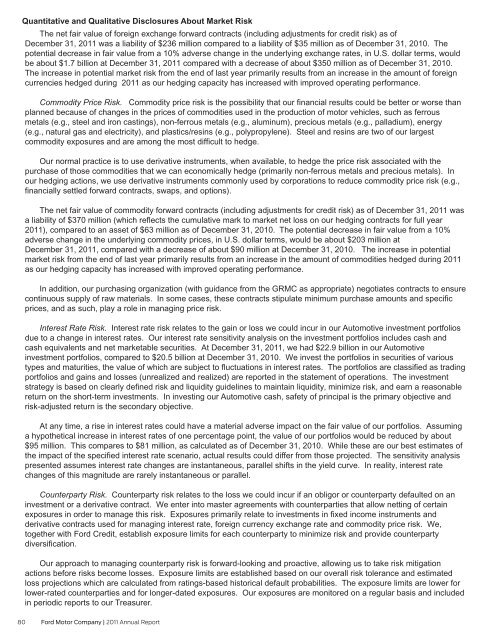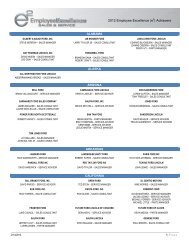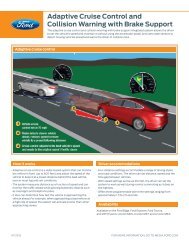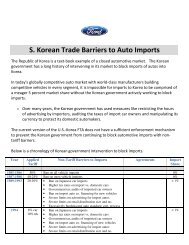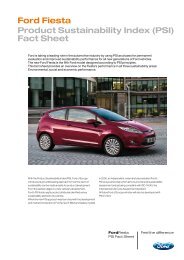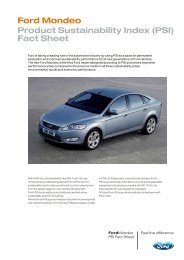Annual Report 2011 - Ford Motor Company
Annual Report 2011 - Ford Motor Company
Annual Report 2011 - Ford Motor Company
You also want an ePaper? Increase the reach of your titles
YUMPU automatically turns print PDFs into web optimized ePapers that Google loves.
Quantitative and Qualitative Disclosures About Market Risk<br />
The net fair value of foreign exchange forward contracts (including adjustments for credit risk) as of<br />
December 31, <strong>2011</strong> was a liability of $236 million compared to a liability of $35 million as of December 31, 2010. The<br />
potential decrease in fair value from a 10% adverse change in the underlying exchange rates, in U.S. dollar terms, would<br />
be about $1.7 billion at December 31, <strong>2011</strong> compared with a decrease of about $350 million as of December 31, 2010.<br />
The increase in potential market risk from the end of last year primarily results from an increase in the amount of foreign<br />
currencies hedged during <strong>2011</strong> as our hedging capacity has increased with improved operating performance.<br />
Commodity Price Risk. Commodity price risk is the possibility that our financial results could be better or worse than<br />
planned because of changes in the prices of commodities used in the production of motor vehicles, such as ferrous<br />
metals (e.g., steel and iron castings), non-ferrous metals (e.g., aluminum), precious metals (e.g., palladium), energy<br />
(e.g., natural gas and electricity), and plastics/resins (e.g., polypropylene). Steel and resins are two of our largest<br />
commodity exposures and are among the most difficult to hedge.<br />
Our normal practice is to use derivative instruments, when available, to hedge the price risk associated with the<br />
purchase of those commodities that we can economically hedge (primarily non-ferrous metals and precious metals). In<br />
our hedging actions, we use derivative instruments commonly used by corporations to reduce commodity price risk (e.g.,<br />
financially settled forward contracts, swaps, and options).<br />
The net fair value of commodity forward contracts (including adjustments for credit risk) as of December 31, <strong>2011</strong> was<br />
a liability of $370 million (which reflects the cumulative mark to market net loss on our hedging contracts for full year<br />
<strong>2011</strong>), compared to an asset of $63 million as of December 31, 2010. The potential decrease in fair value from a 10%<br />
adverse change in the underlying commodity prices, in U.S. dollar terms, would be about $203 million at<br />
December 31, <strong>2011</strong>, compared with a decrease of about $90 million at December 31, 2010. The increase in potential<br />
market risk from the end of last year primarily results from an increase in the amount of commodities hedged during <strong>2011</strong><br />
as our hedging capacity has increased with improved operating performance.<br />
In addition, our purchasing organization (with guidance from the GRMC as appropriate) negotiates contracts to ensure<br />
continuous supply of raw materials. In some cases, these contracts stipulate minimum purchase amounts and specific<br />
prices, and as such, play a role in managing price risk.<br />
Interest Rate Risk. Interest rate risk relates to the gain or loss we could incur in our Automotive investment portfolios<br />
due to a change in interest rates. Our interest rate sensitivity analysis on the investment portfolios includes cash and<br />
cash equivalents and net marketable securities. At December 31, <strong>2011</strong>, we had $22.9 billion in our Automotive<br />
investment portfolios, compared to $20.5 billion at December 31, 2010. We invest the portfolios in securities of various<br />
types and maturities, the value of which are subject to fluctuations in interest rates. The portfolios are classified as trading<br />
portfolios and gains and losses (unrealized and realized) are reported in the statement of operations. The investment<br />
strategy is based on clearly defined risk and liquidity guidelines to maintain liquidity, minimize risk, and earn a reasonable<br />
return on the short-term investments. In investing our Automotive cash, safety of principal is the primary objective and<br />
risk-adjusted return is the secondary objective.<br />
At any time, a rise in interest rates could have a material adverse impact on the fair value of our portfolios. Assuming<br />
a hypothetical increase in interest rates of one percentage point, the value of our portfolios would be reduced by about<br />
$95 million. This compares to $81 million, as calculated as of December 31, 2010. While these are our best estimates of<br />
the impact of the specified interest rate scenario, actual results could differ from those projected. The sensitivity analysis<br />
presented assumes interest rate changes are instantaneous, parallel shifts in the yield curve. In reality, interest rate<br />
changes of this magnitude are rarely instantaneous or parallel.<br />
Counterparty Risk. Counterparty risk relates to the loss we could incur if an obligor or counterparty defaulted on an<br />
investment or a derivative contract. We enter into master agreements with counterparties that allow netting of certain<br />
exposures in order to manage this risk. Exposures primarily relate to investments in fixed income instruments and<br />
derivative contracts used for managing interest rate, foreign currency exchange rate and commodity price risk. We,<br />
together with <strong>Ford</strong> Credit, establish exposure limits for each counterparty to minimize risk and provide counterparty<br />
diversification.<br />
Our approach to managing counterparty risk is forward-looking and proactive, allowing us to take risk mitigation<br />
actions before risks become losses. Exposure limits are established based on our overall risk tolerance and estimated<br />
loss projections which are calculated from ratings-based historical default probabilities. The exposure limits are lower for<br />
lower-rated counterparties and for longer-dated exposures. Our exposures are monitored on a regular basis and included<br />
in periodic reports to our Treasurer.<br />
80 <strong>Ford</strong> <strong>Motor</strong> <strong>Company</strong> | <strong>2011</strong> <strong>Annual</strong> <strong>Report</strong>


